Perceptions of students regarding the effects of the implementation of the tobacco control act of 1999 on a South African University campus
Keywords:
Smoking, South Africa, smoking regulations, university students, Tobacco Control Act
Abstract
Background: Smoking among adolescents is high. In order to curb the habit, restrictions on use of tobacco products in public places were implemented in South Africa. This study aimed to explore students’ perceptions of whether the implementation of smoking restrictions and no-smoking signs have had any effects on smoking behaviours on campus. Methods: A quantitative cross-sectional study was conducted amongst university students, who completed a self-administered questionnaire. Results: Students were aware that smoking causes disease and that second-hand smoke is dangerous. The majority were pleased that there was a smoking regulation in effect, but disagreed that it created a healthier atmosphere. Many would like a total ban enforced in restaurants, clubs, bars and university campuses. They felt that there were insufficient non-smoking signs in public areas. Many smokers stated that they ignored regulations and only a minority stated that the policy encouraged smokers to quit. Conclusion: Smoking among students has decreased over the years. This has been accompanied by an increase in knowledge of the harmful effects of smoking. Regulations have thus had a positive effect; however, additional efforts are required to motivate more people to quit smoking altogether and to prevent young people from taking up the habit. (Full text of the research articles are available online at www.medpharm.tandfonline.com/ojfp) S Afr Fam Pract 2017; DOI: 10.1080/20786190.2016.1254930
Published
2017-03-06
Section
Original Research
By submitting manuscripts to SAFP, authors of original articles are assigning copyright to the South African Academy of Family Physicians. Copyright of review articles are assigned to the Publisher, Medpharm Publications (Pty) Ltd, unless otherwise specified. Authors may use their own work after publication without written permission, provided they acknowledge the original source. Individuals and academic institutions may freely copy and distribute articles published in SAFP for educational and research purposes without obtaining permission.

